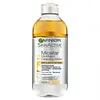What's inside
What's inside
 Key Ingredients
Key Ingredients

 Benefits
Benefits

 Concerns
Concerns

 Ingredients Side-by-side
Ingredients Side-by-side

Water
Skin ConditioningGlycereth-7 Caprylate/Caprate
EmulsifyingPEG-20 Glyceryl Triisostearate
EmollientGlycerin
HumectantHydrolyzed Pea Protein
EmollientHydrolyzed Sodium Hyaluronate
Skin ConditioningSodium Hyaluronate
HumectantAllantoin
Skin ConditioningAlpha-Glucan Oligosaccharide
CleansingCetrimonium Bromide
AntimicrobialCitric Acid
BufferingCopper Gluconate
Skin ConditioningDisodium EDTA
Fructose
HumectantGlucose
HumectantGlycine
BufferingHydrolyzed Rice Protein
Skin ConditioningMagnesium Aspartate
Skin ConditioningMaltose
MaskingPanthenol
Skin ConditioningParfum
MaskingPentylene Glycol
Skin ConditioningProline
Skin ConditioningSodium Chloride
MaskingSodium Hydroxide
BufferingSodium Lactate
BufferingSodium PCA
HumectantTocopheryl Acetate
AntioxidantTrehalose
HumectantUrea
BufferingZinc Gluconate
Skin ConditioningChlorphenesin
AntimicrobialPhenoxyethanol
PreservativePotassium Sorbate
PreservativeSodium Benzoate
MaskingBenzyl Alcohol
PerfumingWater, Glycereth-7 Caprylate/Caprate, PEG-20 Glyceryl Triisostearate, Glycerin, Hydrolyzed Pea Protein, Hydrolyzed Sodium Hyaluronate, Sodium Hyaluronate, Allantoin, Alpha-Glucan Oligosaccharide, Cetrimonium Bromide, Citric Acid, Copper Gluconate, Disodium EDTA, Fructose, Glucose, Glycine, Hydrolyzed Rice Protein, Magnesium Aspartate, Maltose, Panthenol, Parfum, Pentylene Glycol, Proline, Sodium Chloride, Sodium Hydroxide, Sodium Lactate, Sodium PCA, Tocopheryl Acetate, Trehalose, Urea, Zinc Gluconate, Chlorphenesin, Phenoxyethanol, Potassium Sorbate, Sodium Benzoate, Benzyl Alcohol
Water
Skin ConditioningCyclopentasiloxane
EmollientIsohexadecane
EmollientArgania Spinosa Kernel Oil
EmollientBenzyl Alcohol
PerfumingBenzyl Salicylate
PerfumingButyl Methoxydibenzoylmethane
UV AbsorberCI 60725
Cosmetic ColorantDecyl Glucoside
CleansingDipotassium Phosphate
BufferingDisodium EDTA
Ethylhexyl Methoxycinnamate
UV AbsorberEthylhexyl Salicylate
UV AbsorberGeraniol
PerfumingHaematococcus Pluvialis Extract
AntioxidantHexylene Glycol
EmulsifyingLimonene
PerfumingLinalool
PerfumingPentaerythrityl Tetra-Di-T-Butyl Hydroxyhydrocinnamate
AntioxidantPolyaminopropyl Biguanide
PreservativePotassium Phosphate
BufferingSodium Chloride
MaskingParfum
MaskingWater, Cyclopentasiloxane, Isohexadecane, Argania Spinosa Kernel Oil, Benzyl Alcohol, Benzyl Salicylate, Butyl Methoxydibenzoylmethane, CI 60725, Decyl Glucoside, Dipotassium Phosphate, Disodium EDTA, Ethylhexyl Methoxycinnamate, Ethylhexyl Salicylate, Geraniol, Haematococcus Pluvialis Extract, Hexylene Glycol, Limonene, Linalool, Pentaerythrityl Tetra-Di-T-Butyl Hydroxyhydrocinnamate, Polyaminopropyl Biguanide, Potassium Phosphate, Sodium Chloride, Parfum
 Reviews
Reviews

Ingredients Explained
These ingredients are found in both products.
Ingredients higher up in an ingredient list are typically present in a larger amount.
Benzyl Alcohol is most commonly used as a preservative. It also has a subtle, sweet smell. Small amounts of Benzyl Alcohol is not irritating and safe to use in skincare products. Most Benzyl Alcohol is derived from fruits such as apricots.
Benzyl Alcohol has both antibacterial and antioxidant properties. These properties help lengthen the shelf life of products. Benzyl Alcohol is a solvent and helps dissolve other ingredients. It can also improve the texture and spreadability.
Alcohol comes in many different forms. Different types of alcohol will have different effects on skin. This ingredient is an astringent alcohol.
Using high concentrations of these alcohols are drying on the skin. They may strip away your skin's natural oils and even damage your skin barrier. Astringent alcohols may also irritate skin.
Other types of astringent alcohols include:
According to the National Rosacea Society based in the US, you should be mindful of products with these alcohols in the top half of ingredients.
Any type of sanitizing product will have high amounts of alcohol to help kill bacteria and viruses.
Learn more about Benzyl AlcoholDisodium EDTA plays a role in making products more stable by aiding other preservatives.
It is a chelating agent, meaning it neutralizes metal ions that may be found in a product.
Disodium EDTA is a salt of edetic acid and is found to be safe in cosmetic ingredients.
Learn more about Disodium EDTAParfum is a catch-all term for an ingredient or more that is used to give a scent to products.
Also called "fragrance", this ingredient can be a blend of hundreds of chemicals or plant oils. This means every product with "fragrance" or "parfum" in the ingredients list is a different mixture.
For instance, Habanolide is a proprietary trade name for a specific aroma chemical. When used as a fragrance ingredient in cosmetics, most aroma chemicals fall under the broad labeling category of “FRAGRANCE” or “PARFUM” according to EU and US regulations.
The term 'parfum' or 'fragrance' is not regulated in many countries. In many cases, it is up to the brand to define this term.
For instance, many brands choose to label themselves as "fragrance-free" because they are not using synthetic fragrances. However, their products may still contain ingredients such as essential oils that are considered a fragrance by INCI standards.
One example is Calendula flower extract. Calendula is an essential oil that still imparts a scent or 'fragrance'.
Depending on the blend, the ingredients in the mixture can cause allergies and sensitivities on the skin. Some ingredients that are known EU allergens include linalool and citronellol.
Parfum can also be used to mask or cover an unpleasant scent.
The bottom line is: not all fragrances/parfum/ingredients are created equally. If you are worried about fragrances, we recommend taking a closer look at an ingredient. And of course, we always recommend speaking with a professional.
Learn more about ParfumChances are, you eat sodium chloride every day. Sodium Chloride is also known as table salt.
This ingredient has many purposes in skincare: thickener, emulsifier, and exfoliator.
You'll most likely find this ingredient in cleansers where it is used to create a gel-like texture. As an emulsifier, it also prevents ingredients from separating.
There is much debate on whether this ingredient is comedogenic. The short answer - comedogenic ratings don't tell the whole story. Learn more about comegodenic ratings here.
The concensus about this ingredient causing acne seems to be divided. Research is needed to understand if this ingredient does cause acne.
Scrubs may use salt as the primary exfoliating ingredient.
Learn more about Sodium ChlorideWater. It's the most common cosmetic ingredient of all. You'll usually see it at the top of ingredient lists, meaning that it makes up the largest part of the product.
So why is it so popular? Water most often acts as a solvent - this means that it helps dissolve other ingredients into the formulation.
You'll also recognize water as that liquid we all need to stay alive. If you see this, drink a glass of water. Stay hydrated!
Learn more about Water